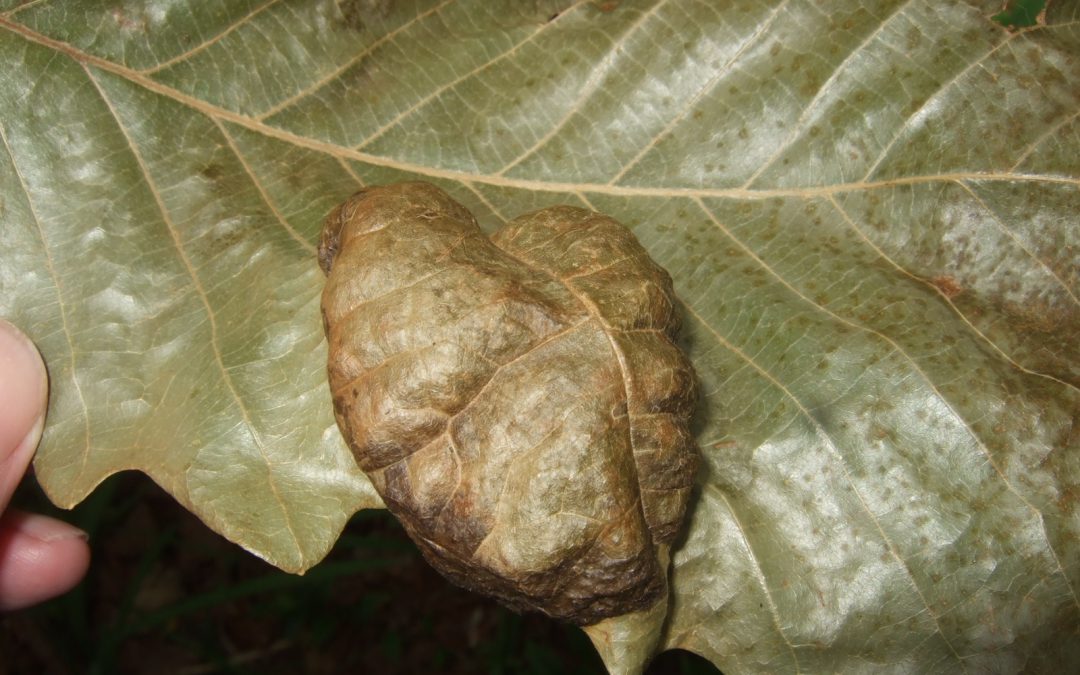
by Mark Tancig | Apr 30, 2020
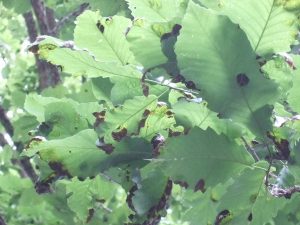
Symptoms of oak leaf blister on swamp chestnut oak. Credit: Gordon Magill.
Even during global pandemics, it’s a joy to be outside during the great north Florida spring we’ve been experiencing lately. As cold fronts come through with their rain bands, some packing a punch, they leave behind the most pleasant mornings, clear blue daytime skies, and crisp evenings. Unfortunately, we’re not the only organism that also enjoys those cool days. Many species of fungi are quite active this type of year as the rains, followed by warmer, yet not too hot temperatures, create the perfect conditions for fungal growth. Some of these fungi grow right on or in the plants we’d like to be enjoying for ourselves, stealing nutrients and causing plant decline or merely causing aesthetic damage. As this is an active time for certain species of fungi, local extension offices are getting more calls and questions regarding lawn and landscape damage due to fungal pathogens. A recent call was a new one for me and an example of a native fungi-plant interaction that looks bad but requires no intervention from us. It also highlights how correctly identifying a disease leads to the best action and can often save time and money and prevent unnecessary pesticides (in this case a fungicide) from entering the environment.
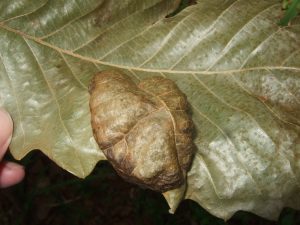
Close up of oak leaf blister on swamp chestnut oak. Credit: Gordon Magill.
The fungi and plant involved here was the oak leaf blister (Taphrina caerulescens) on a swamp chestnut oak (Quercus michauxii). It forms, you guessed it, blisters on the leaves of any of the oaks, though live oak (Quercus virginiana), laurel oak (Quercus laurifolia), and water oak (Quercus nigra) seem to be preferred hosts. The spores of the fungi, dormant since the previous summer/fall and which happen to get lodged in bud scales through wind and rain, germinate in cool, wet weather. The fungus then infects young leaves as they flush and its growth causes a disruption in the leaves’ development. This leads to the blistered look of the leaf tissue and, during extended periods of cool, wet weather, the entire leaf sort of shrivels, browns, and eventually falls off. Spores are eventually released from the fallen leaves to start the process over the next spring.
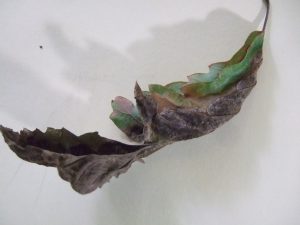
Severe oak leaf blister on swamp chestnut oak. Credit: Gordon Magill.
Though the leaves look pretty terrible, this fungal disease rarely causes plant health issues and the tree recovers just fine. Specimen trees that experience it year to year may be treated with a fungicide, but most homeowners can just let it go. Raking up and disposing of the leaves may help prevent further infections by reducing the number of spores released in the area.
As you enjoy another cool morning after an evening rainstorm, remember that the fungi all around you are also having a great day. You may want to look at your landscape plants and see if there’s anything abnormal going on. If so, take a photo and send it to your local extension office for help with identification and best methods of control, or, like in this case, just leaving it alone.
p.s. As I said this was a new one for me and I want to thank Stan Rosenthal, Extension Agent emeritus, for assisting with identification.

by Larry Williams | Apr 29, 2020
In times like these, it seems that our own perceived “problems” pale in comparison to the “big picture.” In my day-to-day work, I have the opportunity to help people solve problems with their landscapes, lawns and gardens. I enjoy the problem solving part of my job as an extension agent.
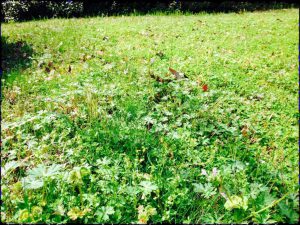
Winter annual weeds in lawn in early spring. Photo credit: Larry Williams
You’d be surprised how upset some people can be about a few weeds, a dying petunia or a tomato with a crack in it. They’ll let small things like this upset their entire world. It’s as if they think we live in a perfect world when it comes to expectations for the plants in their own landscape.
It has become apparent to me that too many people spend too much time letting too many small things bother them too much.
When my twin sister, Linda, and I were growing up in a small town in middle Georgia, an elderly couple (Mr. and Mrs. Hunt) would crack pecans and give the shelled halves to us to eat. They’d hand the shelled pecans to us over the fence that separated our yards. At five or six years old this was a treat for my sister and me.
I remember their landscape. I remember Mrs. Hunt sweeping their dirt driveway lined with coconut sized rocks. She used handmade brooms. I remember their pink flowering dogwoods in spring. I remember their old-fashioned yellow and orange daylilies during summer. I remember the fascination of seeing red spider lilies seemingly come from nowhere in the fall underneath deciduous trees as they displayed their autumn colors. I remember Mrs. Hunt letting me smell a flower from a sweetshrub plant, which reminded me of sweet apples. The deep red blooms and dark green leaves of this shrub complemented the white wooden wall on the east side of their home.
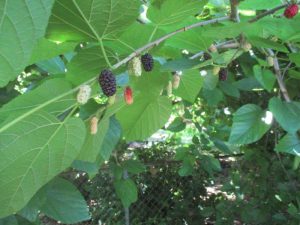
Mulberry tree with fruit. Photo credit: Larry Williams
I remember climbing a large mulberry tree in their backyard and picking and eating the berries. I remember watching Mr. Hunt prune grapevines growing on an overhead trellis. I remember learning about the history of a ginkgo tree planted just outside a chicken pin in their side yard. I remember watching hummingbirds flying in and out of the reddish orange funnel-shaped blooms of a large trumpet vine growing on an old metal frame of a water tank.
I don’t remember the weeds, even though I know there must have been weeds in the Hunt’s landscape. I know there was the occasional pecan that didn’t fill out or that was worm infested. And I’m sure an occasional plant had to be replaced. But these are not the things that made lasting impressions for me.
The big picture is not the weeds, the dying petunia plant or the pecan with a worm in it. Sure you will have weeds in your yard and certain plants that don’t survive. Just don’t let these things become the source of worry. In my opinion, a landscape should be a source of pleasure, a place to learn and a place to pass along lasting memories. Besides, with all the things there are to worry about in this world (as recent days have revealed), why let your own backyard be one of them?
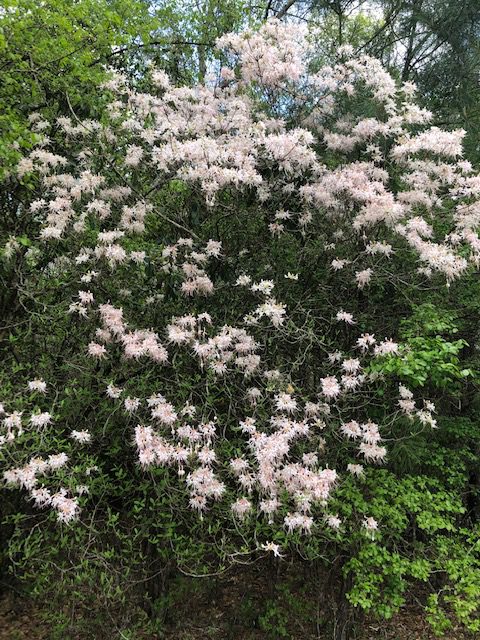
by Carrie Stevenson | Apr 15, 2020
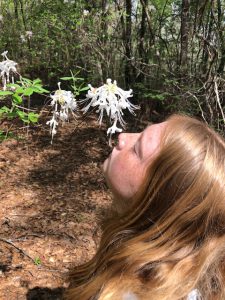
The sight and scent of a wild azalea blooming in the woods can stop you in your tracks! Photo credit: Carrie Stevenson, UF IFAS Extension
From a distance, native azaleas are easily mistaken for honeysuckle vines. With long, arching stamens, you might be tempted to relive your childhood, hoping to pull the pistil from the bottom and find a single drop of sweetness on the end. Instead, upon close observation you will encounter an equally pleasurable but distinctly different scent. The wild Rhododendron canescens, known variously as a mountain, piedmont, or honeysuckle azalea, can range in flower color from white to deep pink. In northwest Florida, you will find it on the edges of swamps, or as I did on the sunny fringes of wooded areas with rich, moist soil. It is in bloom right now (March), along with its cousins, the white-blooming swamp azalea (Rhododendron viscosum) and the brilliant orange Florida flame azalea (Rhododendron austrinum).
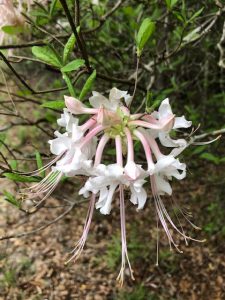
The delicate flower of a honeysuckle azalea attracts hummingbirds and butterflies in the spring. Photo credit: Carrie Stevenson, UF IFAS Extension
Native azalea populations have declined due to wetland habitat loss, and their delightful smell and delicate flowers have made them susceptible to overcollection. Due to these factors, the Florida flame azalea is listed on the state endangered species list and wild azaleas should never be removed from their habitat. Native azalea species attract butterflies and hummingbirds, and are often planted in home landscapes as ornamental shrubs. Be sure you purchase them from reputable dealers that are not collecting from the wild.
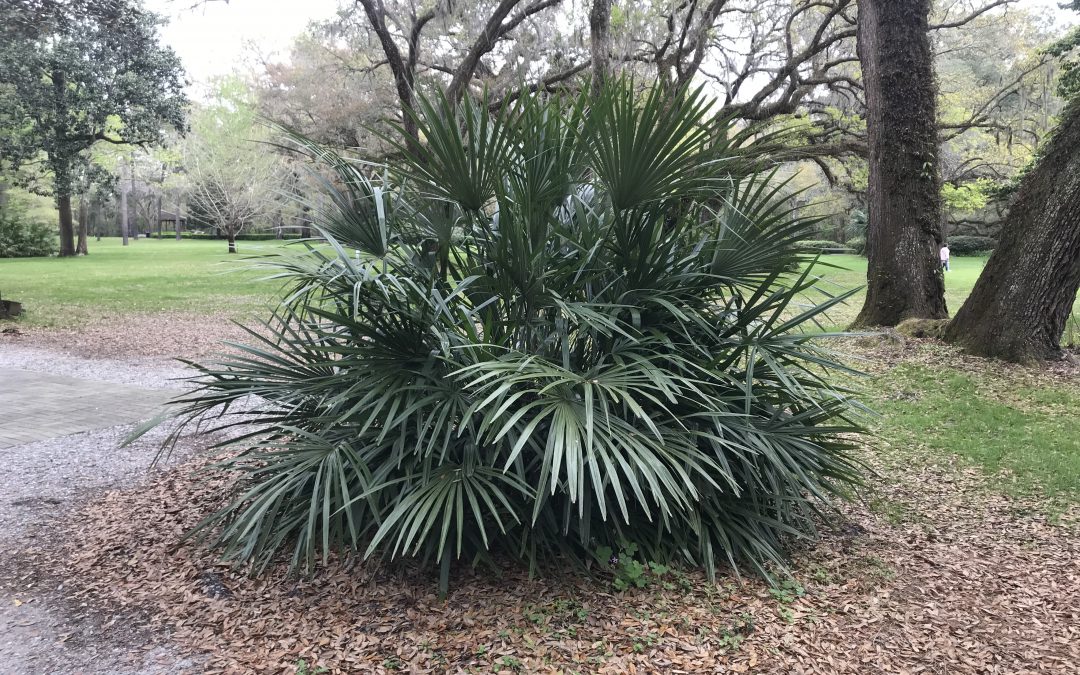
by Daniel J. Leonard | Apr 8, 2020
There aren’t a lot of quality landscape plant options that fit the description nearly every homeowner desires: native, low-maintenance, slow-growing, pest free, drought tolerant while tolerating wet soils, loving both sun or shade, and green year-round. Needle Palm (Rhapidophyllum hystrix) is the rare plant that checks all those boxes and deserves consideration when adding plants to your landscape!
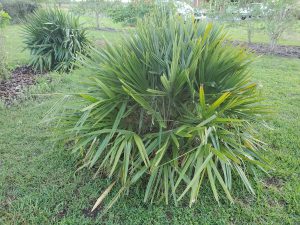
6 year old Needle Palm in a local landscape. Photo courtesy the author
Needle Palm is an endangered native, growing in a narrow range in the coastal Southeastern US, Calhoun and Liberty counties included. It is primarily found in the understories of wet wooded areas along slopes, ravines, and bottoms; if you’ve ever hiked the Apalachicola Ravines or Torreya State Park trails, you’ve likely encountered Needle Palm in the wild! Being native is nice, but what makes Needle Palm an outstanding landscape option?
Needle Palm is the prettier, more refined cousin of Saw Palmetto (Serenoa repens), which it is sometimes confused with. Unlike the rambling, aggressive, stiff-leaved palmetto, Needle palm possesses “softer”, finely cut, lustrous evergreen leaves, allowing it to add amazing texture to any landscape. Also, unlike palmetto, it doesn’t need a yearly “cleaning” to prune out brown, dead leaves, rather its leaves persist green and clean for many years! You might not want to reach into the interior of a Needle Palm plant anyway, as generally unseen 6-8” namesake “needles” surround the base of its trunk. Needle Palm grows very slowly, eventually reaching 8’ tall or so, but is more often seen in the 4-6’ range in landscapes. This is absolutely a shrub that will never outgrow its welcome. It is a nearly trunkless palm, almost always appearing as a shrub, though with extreme old age it can begin to look a bit like a small tree with a muted trunk. With outstanding aesthetics and a low-maintenance growth habit, Needle Palm has a place in nearly any landscape.
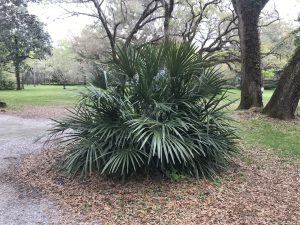
Mature needle palm, 6′ tall and wide. Photo courtesy the author.
In the landscape, Needle Palm does best when sited with some shade in the afternoon but also thrives in full sun. They appreciate regular water during establishment but survive on their own without any extra irrigation after! Needle Palm also doesn’t need much in the way of supplemental fertilization. They do look their best with a light spring application of a general purpose, slow-release fertilizer, but this is not required. Needle Palms are not afflicted with the pest and pathogen problems the much more commonly used non-native Sago Palms (Cycas revlolutas) attracts. I’ve grown Needle Palm for 6 years in the landscape and have never noticed any pest or disease issues. With Needle Palms becoming more common in the nursery trade, I don’t see a place in most landscapes for the inferior, high-maintenance, insect infested Sagos. If you want the tropical, textured look of Sagos, plant Needle Palm instead.
Needle Palm is an extremely attractive, low-maintenance Northwest Florida native plant that you should absolutely seek out and add to your landscape! If you want more information or have any questions about Needle Palm or any other landscape/garden topic, please give your local UF/IFAS County Extension Office a call. Happy Gardening!
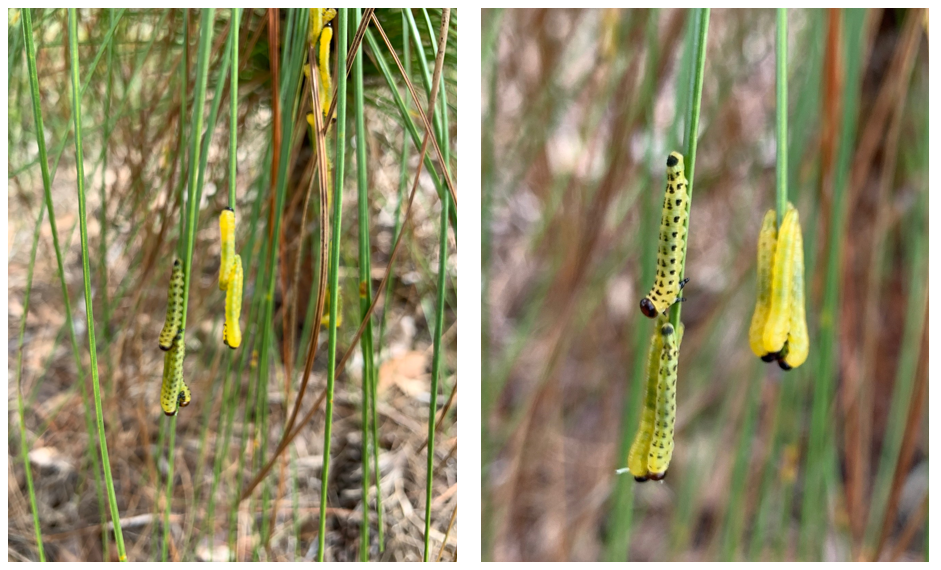
by Ray Bodrey | Apr 8, 2020
Spring has arrived and so have the insects. Caterpillars are crawling around and one possesses a unique appetite.
Neodiprion spp. is the most common defoliating insect group affecting pine trees. In all, there are 35 species that are native to the U.S. and Canada. The redheaded pine sawfly, Neodiprion lecontei, is the primary species found in the Florida Panhandle.
Adult sawflies can be as large as 1/3 of an inch in length. The female can be two-thirds larger than the male and are mostly black with a reddish-brown head, with occasional white coloration on the sides of the abdomen.
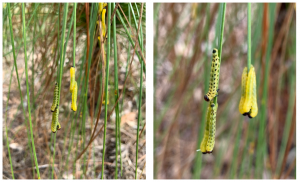
Mature larvae of the redheaded pine sawfly. Credit: Patty Dunlap, Gulf County Master Gardener.
The ovipositor, the tube-like organ used for laying eggs, is saw-like, hence the common name. During the fall, females make slits in pine needles and deposit individual eggs, up to 120 eggs at a time. The eggs are shiny, translucent and white-hued. Mature larvae (caterpillars), as seen in the accompanying photo, are yellow-green, emerge in the spring and feast on pine needles. After weeks of feeding on needles, the mature larvae drop to the ground. The cocoon, a reddish-brown, thin walled cylinder, is spun in the upper layer of the soil horizon or in the leaf litter; this is called the pupae stage. The pupae overwinter, and adults emerge from the cocoon in the spring of the following year.
Mature larvae are attracted to young, open growing pine stands. Pine is the preferred host, but cedar and fir, where native, are secondary food sources. Neodiprion lecontei is an important defoliator of commercially grown pine, as the preferred feeding conditions for sawfly larvae are enhanced in monocultures of shortleaf, loblolly, and slash pine, all of which are commonly cultivated in the southern United States. Defoliation can kill or slow the growth of pine trees as well as predispose trees to other insects or disease.
Are there control methods? Yes, biological control is a major factor, as natural enemies are numerous. Disease, viruses and predators help regulate population control. For small scale control, physically removing eggs or larvae is key. Again, most infestations occur on younger tree plantings, so they’ll be in reach. Be sure to scout young pines for signs of infestation. Horticultural soaps and oils are effective chemical controls, if needed.
For more information, contact your local county extension office.
Supporting information for this article can be found in the UF/IFAS Extension EDIS publication, “Redheaded Pine Sawfly Neodiprion lecontei” by Sara DeBerry: https://edis.ifas.ufl.edu/pdffiles/IN/IN88200.pdf
UF/IFAS Extension is an Equal Opportunity Institution.

by Matt Lollar | Mar 20, 2020
It’s always fun to add new plant to the landscape. And it’s even more fun to propagate your own plant material. The question is, what plant propagation method is best? The answer depends on a number of factors such as:
- How much time and money is available?
- Is a uniform crop desired or is trait variation preferred?
- What is the plant species being propagated?
Plants can be propagated either by seed (sexual propagation) or by segments of vegetative material (asexual propagation). Sexual propagation takes far less time and effort because new plants are being started from the seeds (offspring) of parent plants. This type of propagation promotes genetic diversity because offspring may not have the exact characteristics of the parent plants. Sexual propagation increases the possibility of hybrid vigor, which is the improved quality of plant material to that of parent plants. Asexual propagation usually takes more time, but generally ensures that propagated plants will maintain the same characteristics as the parent plant. For some species it may be the only way to pass on desired traits to subsequent generations and it may be the only way to propagate certain species. A plant produced vegetatively can become larger than a plant produced by see in the same amount of time.
Tips for Successful Sexual Propagation
- Seed Collection – Seeds should be collected when fruit is ripe, just before they fall to the ground. In general, seeds should be cleaned, dried, and stored at 40 degrees Fahrenheit (in a refrigerator). However, palm seeds should be planted immediately after harvesting and cleaning.
- Seed Dormancy – Some seeds have thick seed coats the inhibit germination. Some seeds need to be scarified (breaking of the seed coat) and/or stratified (stored in a specific environment) in order to germinate.
- Seed Sowing – Seeds can be germinated in flats or other suitable containers in a seed starting media. Seeds should be planted at a depth of two to three times their diameter, but no deeper than 3 inches. Cycad seeds should be planted just below the medium surface.
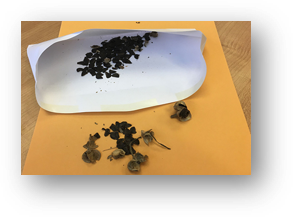
Seeds stored in an envelope. Photo Credit: University of Florida/IFAS
Tips for Successful Asexual Propagation – In general, asexual propagation is the propagation of plant material from cuttings of stems, leaves, and/or roots.
- Rooting Hormones – Increase rooting percentage, hasten root initiation, increase the number of roots per cutting, and increase root uniformity. Auxin based rooting hormones (Indolebutyric acid (IBA) and Naphthalenacetic acid (NAA)) are available in dry or liquid forms. It is important to use the correct concentration for the particular plant species because over application can cause damage to cutting base.
- Sticking Cuttings – Cuttings should be stuck in the medium only deep enough to support the cuttings and hold them upright (1/2″ to 1″ deep).
- Post-Rooting Care – Fertilization should be applied as soon as roots emerge from the cuttings. However, overfetilization can increase soluble salts and burn roots.
Examples of Asexual Propagation
- Softwood Cuttings – Taken from woody plants usually three to four weeks after a new flush of growth. Commonly propagated species using this method include: crape myrtle; magnolia; oleander; azalea; jasmine; and boxwood.
- Semihardwood Cuttings – Similar to softwood cuttings, but the lower portion of the cutting has become lignified (woody). Usually taken from new shoots six to nine weeks after a flush of growth. Commonly propagated species using this method include: camellia; pittosporum; junipers; and some hollies.
- Hardwood Cuttings – Taken from the previous season’s growth, just before or during the dormant period. Commonly propagated species using this method include narrow-leaved evergreens and deciduous species during the dormant season after leaves have dropped.
- Leaf Cuttings – Comprised of only the leaf blade or the leaf blade and petiole (leaf stalk). Cuttings are stuck upright in the propagation medium with the basal end (petiole end) of the leaf inserted into the propagation medium. Commonly propagated species using this method include begonias and peperomias.
- Root Cuttings – Taken in late winter or early spring from two to three-year-old plant material. Plants propagated by root cuttings may not reproduce true to type if they are budded or grafted. Commonly propagated species using this method include: plumbago; bayberry; oakleaf hydrangea; and yucca.

Plants being propagated by leaf cuttings. Photo Credit: University of Florida/IFAS
This article provides only a brief overview of propagation methods and techniques. For more information on plant propagation please visit University of Florida Plant Propagation Glossary or Plant Propagation Techniques for the Florida Gardener. Please be advised that some plant material is patented and it is illegal to propagate patented material without written authorization or licensing of the patent holder. If it is patented, a notation of patent number will be on the tag.

















